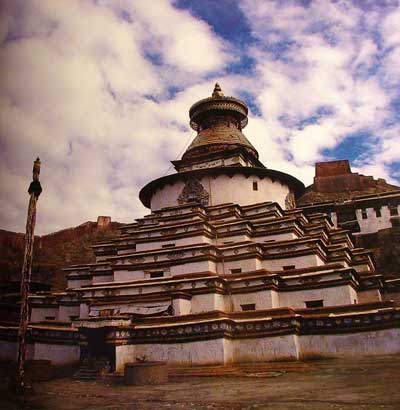
Gyantse Kumbum Pagoda (100,000 Buddha-Statue Pagoda), Pelkor Chode Monastery, at base of Mount Dzongri in Gyantse, Tibet built in 1435. Example of non-sectarianism as every sect of Tibetan Buddhism has their own space in this monastery located in south-central Tibet. Similar in design to the pagodas built by Master Dolpopa and Tangtong Gyalpo.
The root of the non-sectarian or Rime (ri-may) tradition is said to be Lama Dampa Sonam Gyaltsen (1312-1375), the eldest of the fifteen sons of Zangpo Pal, throne holder of the Sakya sect from the Khon family lineage. Lama Dampa was a restorer of the Samye Monastery and teacher of many famous disciples of his era including Longchen Rabjam (1308-1363), the Omniscient One of Vast Space. Although the Tibetan non-sectarian movement was not recognized as such until the late nineteenth century and was seen, in part, as a response to the destructive sectarian fighting that had occurred among the various sects in Tibet, the main objective of the leaders [Jamgon Kongtrul (1813-1899), Jamyang Khyentse (1820-1892), and Chokgyur Lingpa (1829-1879)] was not to create a single school or sect, as is often thought, but to preserve the many traditions and lineages that were at risk of becoming extinct. These incarnate bodhisattvas knew that the many lineages and dharma each offered a means for liberation for beings of varying karmic affinity and should be kept in tact to help living beings of different capacities and temperament. Those who followed the Rime tradition did not necessarily leave their original tradition, but continued their existing practices within the larger framework of the Rime approach that appreciates the differences among the different sects and the need for a variety of dharmas to meet the needs of different living beings. These concepts had been an underlying theme within Tibetan Buddhism for centuries with many of the greatest masters receiving teachings from various schools.

